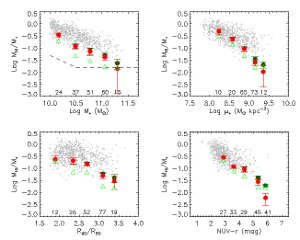|
|  |
Galaxies are well known to divide into two large families: red, old
ellipticals and blue, star-forming spirals (Figure 1). While this
distinction has been known for a long time, recent work based on the
Sloan Digital Sky Survey (SDSS) has shown that, in the local universe, the
division into these two large families happens at a stellar mass
of ~3 1010 Msun (a value very close to the stellar mass of
our own Galaxy, the Milky Way). Galaxies with stellar mass smaller
than the threshold typically have young stellar populations, low
surface mass densities and the low concentrations characteristic of
disks. On the other hand, galaxies with higher stellar mass are
characterized by old stellar populations, high surface mass densities
and the high concentrations typical of bulges. New theoretical work
has led to a diverse set of possible mechanisms to explain this
characteristic mass scale where galaxies transition from young to old,
with nearly all operating via quenching or regulation of the gas
supply. New insight into this problem will come from studying gas in
massive galaxies on both sides of the characteristic stellar mass,
where the transition seems to take place. The cold gas (i.e.
neutral hydrogen, HI) is the source of the material that will
eventually form stars, thus it is clearly a key ingredient to
understand what sets this transition in galaxy properties and test our
theoretical models. In order to obtain an unbiased picture, it is also
very important that the sample be selected according to stellar mass
only, as opposed to optical morphology, star formation properties, gas
richness, colour or other parameters.
This motivated a team of international astronomers, which includes
Barbara Catinella, Guinevere Kauffmann, Silvia Fabello, Jing Wang
at the MPA and several collaborators in other institutions,
to undertake a new programme, the GALEX Arecibo SDSS Survey (GASS).
We target 1000 of the largest and most massive galaxies in the local
universe. These massive galaxies very likely started forming when the
universe was quite young, but in the present day, some appear to have
stopped forming stars. Has star formation stalled in these galaxies
because the gas supply has been fully consumed? Or has the gas been
pushed to the outskirts of these galaxies, or heated to temperatures
that inhibit the gravitational collapse needed to form new stars? GASS
is designed to answer these questions.
GASS probes the relationship between stars and gas by linking several
new large galaxy surveys in visible and ultraviolet light to
observations from Arecibo, the largest radio telescope in the
world. The ground-based visible (SDSS) and space-based ultraviolet
(Galaxy Evolution Explorer, GALEX) surveys measure the young and old
stars in each galaxy, while the Arecibo survey that we are currently
conducting measures the neutral hydrogen content of each galaxy. The
Arecibo observations started in 2008 and are on-going. We observe the
targets until we either detect them or we reach a low gas mass
fraction limit (Figure 2). The first results show that, even in the
high stellar mass regime, ~60% of the galaxies possess a significant
amount of HI gas. We used our initial data set of ~200 galaxies to
explore how the gas fraction depends on structure and stellar
population properties of the sample. We find that the gas fraction of
massive galaxies correlates strongly with stellar mass, stellar
surface mass density and NUV-r colour, but correlates only weakly with
bulge-to-disk ratio (Figure 3).
One of the key goals of GASS is to identify and
quantify the incidence of transition objects, which might be
moving between the blue, star-forming cloud and the red sequence of
passively-evolving galaxies. Depending on their path to or from the
red sequence, these objects should show signs of recent quenching
of star formation or accretion of gas, respectively.
Objects that deviate strongly from the average behavior of the sample
are the best candidates for such transition galaxies.
We have thus identified interesting
objects that are anomalously gas-rich given their colours and
densities, as well as gas-poor galaxies that are still forming stars.
Objects in the first category might be accreting gas from recent
encounters with other galaxies or from the surrounding environment,
and in some cases might even be able to re-grow a star-forming
disk. Objects in the second class may be systems where the
HI gas has recently been stripped by tidal interactions or by
ram-pressure exerted by intergalactic gas, or where other feedback
processes have expelled the gas. In future work, we plan to
investigate these different classes of transition galaxy in more
detail.
In order to further our understanding of the physical
processes causing the transition between blue and red sequence
galaxies, we are also carrying out the COLD GASS ("CO Legacy Database
for GASS") survey. This is an on-going large programme, carried out in
collaboration with colleagues at the MPE and the IRAM observatory in
Granada (Spain), which uses the IRAM 30m radio telescope to measure
the molecular hydrogen content for a third of the GASS sample.
Molecular hydrogen is another key ingredient needed to understand
transition galaxies and constrain theoretical models, because it
represents the intermediate step between the neutral hydrogen
reservoir and the formation of new stars.
Barbara Catinella
Further reading
Catinella, B., Schiminovich, D., Kauffmann, G., et al.,
"The GALEX Arecibo SDSS Survey. I. Gas Fraction Scaling Relations
of Massive Galaxies and First Data Release",
2010, MNRAS, in press
 (arXiv:0912.1610) (arXiv:0912.1610)
 GASS web site GASS web site
 COLD GASS web site COLD GASS web site
 ALFALFA web site ALFALFA web site
 Arecibo observatory web site Arecibo observatory web site
|


